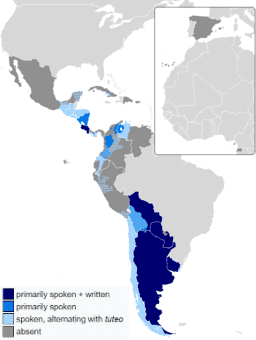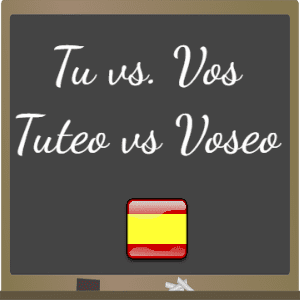In some Spanish-speaking countries, the second-person pronoun “tú” is not used. Instead, the pronoun “vos” is used. In Spanish, the use of “vos” as a second-person pronoun is referred to as voseo, as opposed to the use of “tú,” which is referred to as tuteo. Here, we will learn more about how to use “vos” in Spanish.

Inhakito, CC BY-SA 3.0 https://creativecommons.org/licenses/by-sa/3.0, via Wikimedia Commons
Table of Contents
- Where is “Vos” used in Spanish?
- “Tuteo” vs “Voseo”: “Tú” vs “Vos” in Spanish
- Voseo in the Present Indicative
- Voseo in the Affirmative Imperative Mood
- Voseo in all Other Cases in Spanish
- Quiz: Use of “Voseo” in Spanish: “Vos” vs. “Tú”
- Level VI – Fluent
Where is “Vos” used in Spanish?
The pronoun “vos” is used mainly in some Spanish-speaking countries Argentina, Uruguay, Paraguay, Nicaragua, Costa Rica, and El Salvador. It also has some regional use in other countries.
“Tuteo” vs “Voseo”: “Tú” vs “Vos” in Spanish
Keep in mind that the pronoun “vos” is conjugated differently. For example, instead of saying “Tú hablas inglés,” we say “Vos hablás inglés.” The pronoun “vos” is used instead of “tú.” The “r” in the infinitive ending of “hablar” is replaced with “s,” and an accent is added to the vowel before the last “s” to stress the last syllable.
In general, using “vos” instead of “tú” does not change the conjugation of verbs in Spanish sentences except for the present indicative and the affirmative imperative mood. We will study these two cases separately.
Voseo in the Present Indicative
Forming the present indicative using “vos” is straightforward and has fewer irregular cases than using “tú.” Regular verbs in the present indicative tense follow the conjugation rules shown below:
| -ar ending e.g., hablar | -er ending e.g., comer | -ir ending e.g., vivir | |
| yo | hablo | como | vivo |
| vos | hablás | comés | vivís |
| él/ella/usted | habla | come | vive |
| nosotros/-as | hablamos | comemos | vivimos |
| vosotros/-as | habláis | coméis | vivís |
| ellos/ellas/ustedes | hablan | comen | viven |
As seen above, to form the second-person present indicative using “vos,” the “r” in the infinitive ending is replaced with “s,” and an accent is added to the vowel before the last “s” to stress the last syllable, for example:
| ¿Qué querés comer esta noche? | What do you want to eat tonight? |
| ¿Dónde vivís? | Where do you live? |
| Vos tenés una casa grande. | You have a big house. |
The only irregular verbs in voseo are:
| Infinitive | Second person in the present indicative |
| ser | sos |
| ir | vas |
| haber | has |
For example:
| ¿De dónde sos? | Where are you from? |
| Vos vas a la escuela todos los días. | You go to school every day. |
| Vos has comido el postre. | You have eaten the dessert. |
Voseo in the Affirmative Imperative Mood
Forming the singular imperative mood in the affirmative using “vos” is straightforward and has only one irregular case. Regular verbs follow the conjugation rule shown below:
| -ar ending e.g., hablar | -er ending e.g., comer | -ir ending e.g., vivir | |
| vos | hablá | comé | viví |
To conjugate the verb, the we remove the final “r” in the infinitive and add an accent to the last vowel to stress the last syllable, for example:
| ¡Vení acá! | Come here! |
| ¡Tené cuidado! | Be careful! |
| Comé algo saludable. | Eat something healthy. |
The only irregular case using “vos” in the imperative is the verb “ir,” which has the imperative form “andá,” for example:
| Andá al gimnasio temprano. | Go to the gym early. |
Conjugation of the imperative mood in the negative using “vos” is identical to that using “tú,” for example:
| No vayas a la escuela mañana. | Don’t go to school tomorrow. |
| No comas mucho postre. | Don’t eat a lot of dessert. |
Voseo in all Other Cases in Spanish
Finally, it is important to note that conjugation of all other moods and tenses using “vos” is identical to that of using “tú,” for example:
| Vos viniste muy temprano hoy. | You came early today. |
| Vos estabas dormido cuando llegué. | You were sleeping when I arrived. |
Quiz: Use of “Voseo” in Spanish: “Vos” vs. “Tú”
Next: Uses of “Ojalá” in Spanish
More lessons in Level VI:











